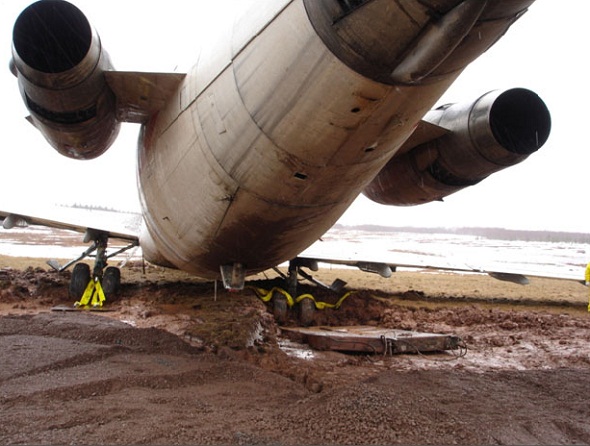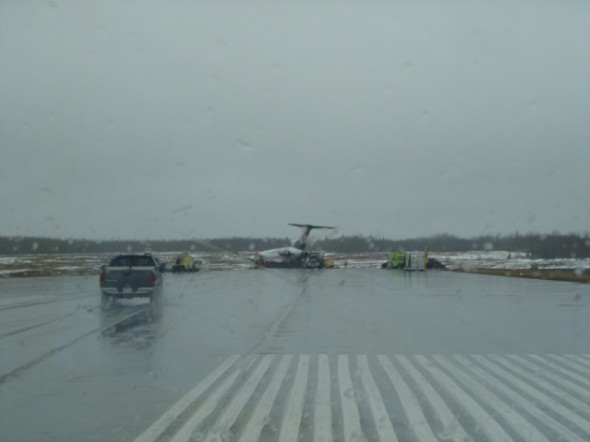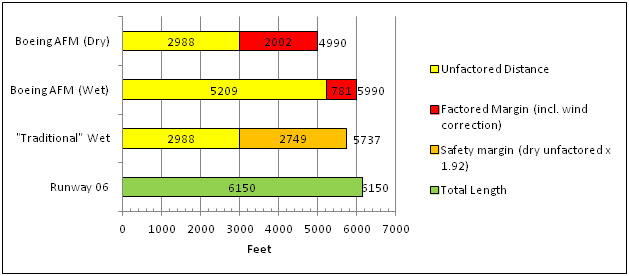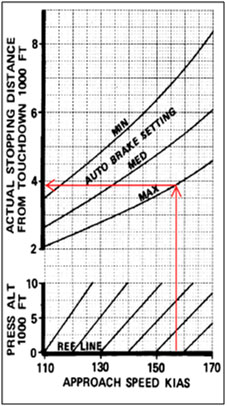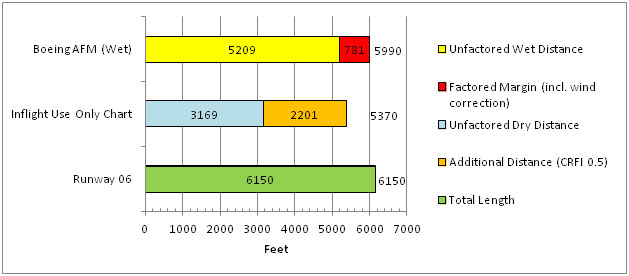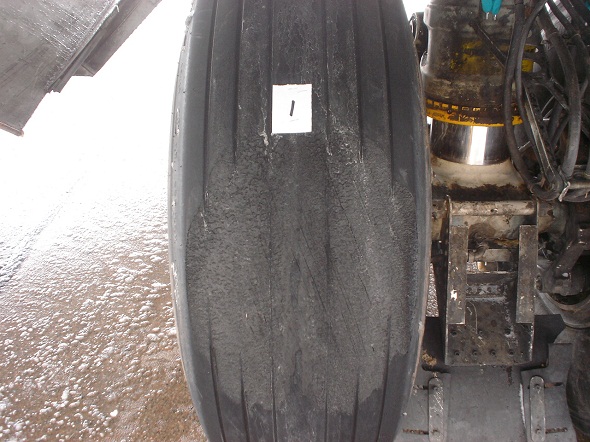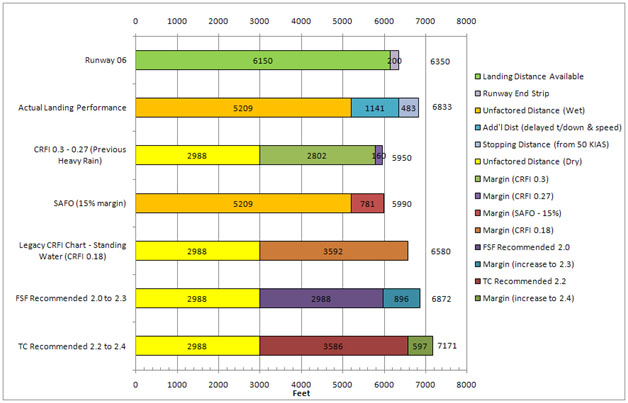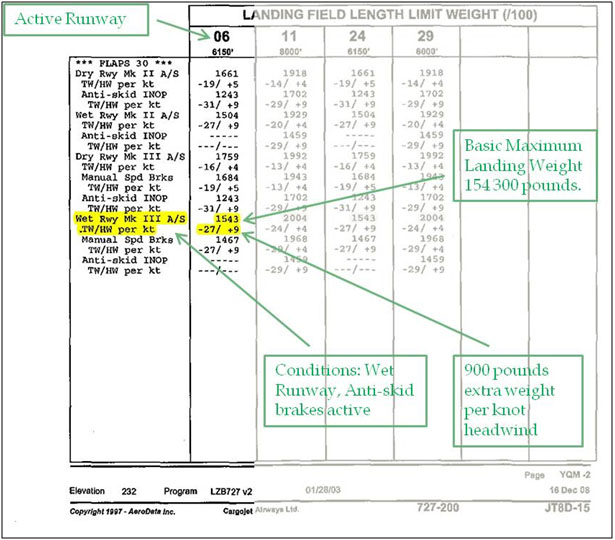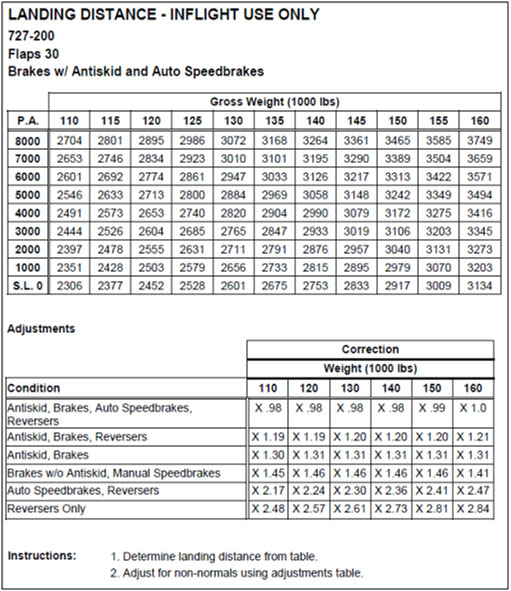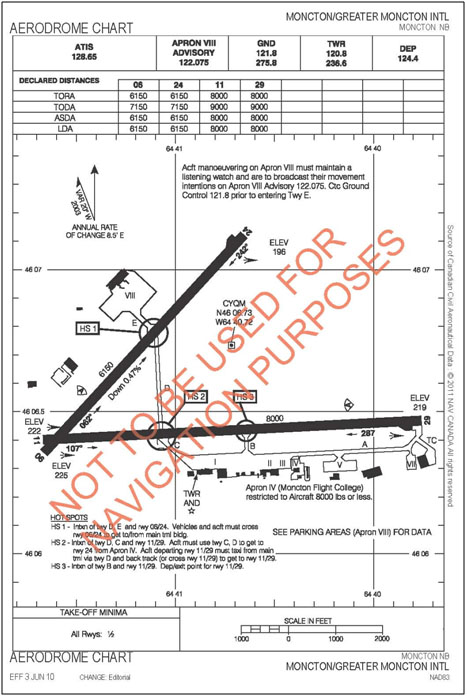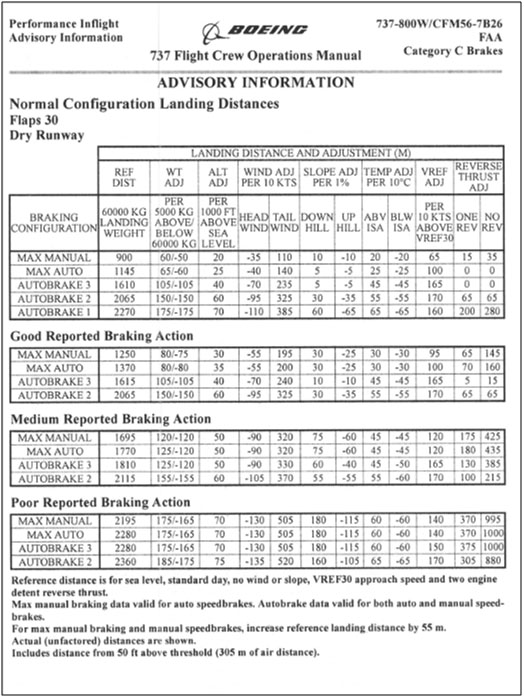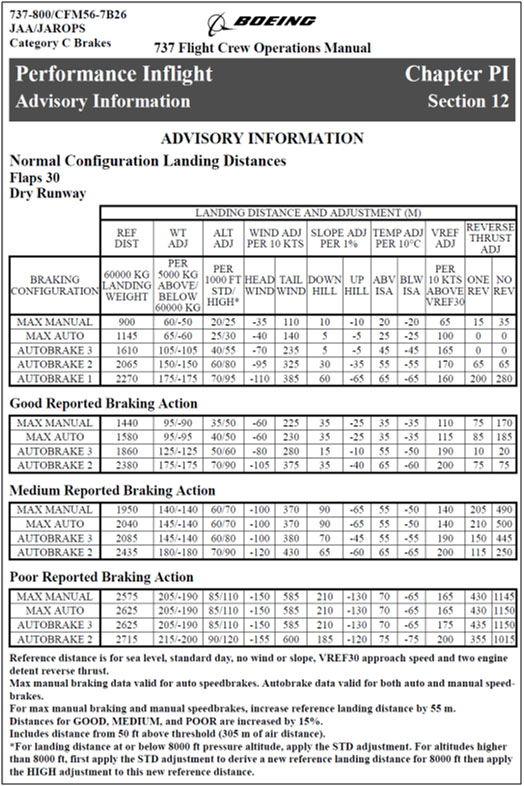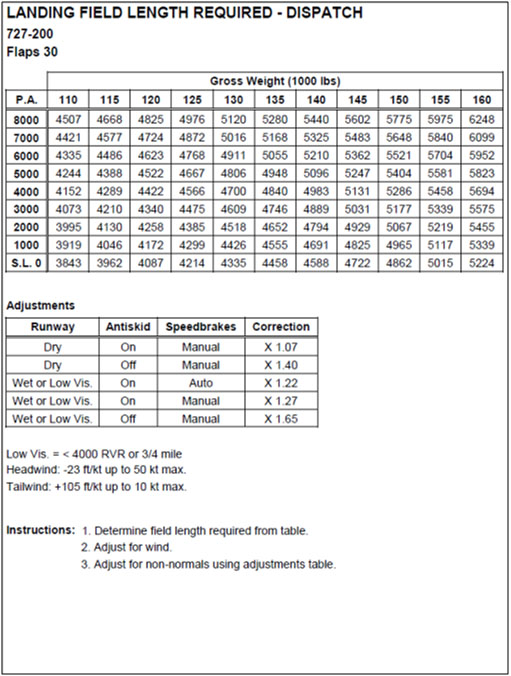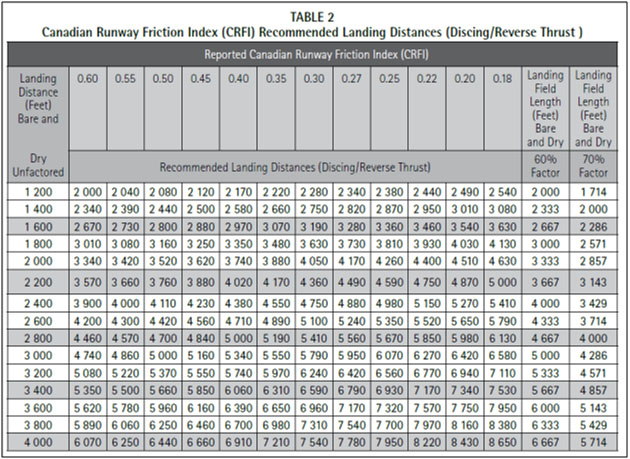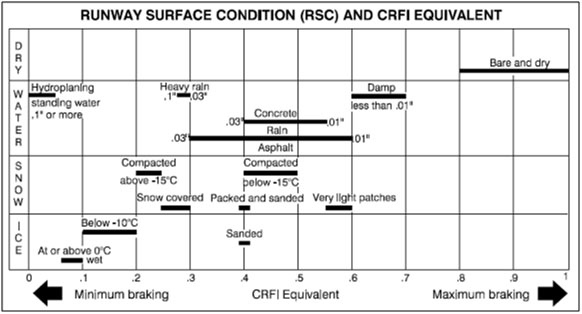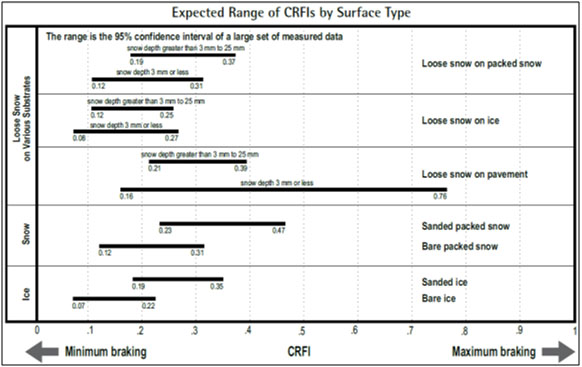Runway Excursion
Cargojet Airways Ltd.
Boeing 727-225, C-GCJZ
Moncton, New Brunswick
The Transportation Safety Board of Canada (TSB) investigated this occurrence for the purpose of advancing transportation safety. It is not the function of the Board to assign fault or determine civil or criminal liability. This report is not created for use in the context of legal, disciplinary or other proceedings. See Ownership and use of content. Masculine pronouns and position titles may be used to signify all genders to comply with the Canadian Transportation Accident Investigation and Safety Board Act (S.C. 1989, c. 3).
Summary
On 24 March 2010, at 0120 Atlantic Daylight Time, a Boeing 727-225 aircraft (registration C-GCJZ, serial number 21854) operated as Cargojet flight 620, departed Hamilton/John Munro International Airport, Ontario, on a scheduled cargo flight to the Greater Moncton International Airport, New Brunswick, with 3 crew members on board. An Instrument Landing System approach was carried out and at 0307, the aircraft touched down on the 6150 foot long Runway 06. Following touchdown, the flight crew were unable to stop the aircraft prior to the end of the runway. The aircraft came to rest in deep mud, the nose wheel approximately 340 feet beyond the runway end and 140 feet beyond the edge of the paved runway end strip. A local fire department responded and arrived on-scene approximately 20 minutes after the aircraft departed the runway. The flight crew exited the aircraft using a ladder provided by the fire fighters. There were no injuries and the aircraft had minor damage.
1.0 Factual Information
1.1 History of flight
Prior to departure, the flight crew carried out their pre-flight preparations, noting that the weather conditions at Moncton included gusting winds and light rain.
Enroute, the flight crew obtained the Automatic Terminal Information Service (ATIS) information Bravo and consulted both the Landing Field Length Limit Weight chart (See Appendix A) and the Landing Distance – Inflight Use Only chart (See Appendix B). Subsequently, the flight crew decided to carry out an Instrument Landing System (ILS) approach to the active runway, Runway 06.
At 0303:57,Footnote 1 prior to glideslope intercept, Cargojet 620 was cleared to land on Runway 06. The surface winds reported by the Moncton tower controller were ° Magnetic (M) at 8 knots gusting to 17 knots. Moments later, the autopilot captured the glideslope and a descent was commenced. Almost simultaneously, the localizer was captured and the aircraft began tracking inbound.
Shortly after establishing on the glideslope and localizer the captain, who was the pilot flying (PF), elected to manually fly the ILS to Runway 06. The autopilot was then disengaged and the landing checklist was initiated. Shortly thereafter, the aircraft drifted above the glideslope, exceeding one dot above on the flight instruments, at approximately 0305:23. This deviation above the glideslope was detected by the first and second officers and, as per the Cargojet SOPs, the appropriate standard callouts were made. The captain responded by taking corrective action to return the aircraft to the glideslope. At approximately 0305:30, the aircraft crossed the final approach fix (i.e., the Riverview non-directional beacon). At that time, the aircraft's altitude was noted to be approximately 50 feet higher than the published glideslope check altitude of 2070 feet above sea level. The aircraft was re-established on the glideslope and remained on the glideslope until it crossed the runway threshold.
Approximately 2 nautical miles (nm) from the threshold, Runway 06 became visible to the flight crew. While on final approach, the aircraft heading was approximately 066° M to correct for a right crosswind. Descending through 600 feet above sea level (asl), the aircraft encountered heavy rain. Upon reaching minima, the wipers were selected on. The aircraft crossed the runway threshold, on glideslope, at 165 knots indicated airspeed (KIAS). The aircraft touched down approximately 9 seconds later between 2000 and 2500 feet from the threshold of Runway 06 at approximately 157 KIAS. From threshold crossing to touchdown, the aircraft's average rate of descent was calculated to be approximately 400 feet per minute. The heading upon touchdown was 59.8° M, 2.2 degrees less than the runway heading of ° M. On touchdown, the automatic speed brakes deployed. Approximately 3 seconds after touchdown, reverse thrust was selected. The aircraft heading then began to veer to the right, reaching a maximum of approximately 068° M. In response, reverse thrust was reduced, however, the manual brakes were not released. Approximately 3 seconds later, with the aircraft passing through the runway heading, maximum reverse thrust was re-applied. The flight crew was unable to stop the aircraft, which passed through the 60-metre long paved runway end strip and departed the paved surface with an indicated airspeed of approximately 50 knots. The aircraft came to a stop in deep mud approximately 27 seconds after touching down on Runway 06 (see Photo 1). Maximum manual wheel braking was applied shortly after touchdown, and maintained by the flight crew throughout the entire landing roll.
After the aircraft stopped, the crew advised the Moncton tower controller of the runway overrun and requested aircraft rescue and fire fighting (ARFF) assistance. After visually confirming that there was no post-crash fire, the flight crew pulled the circuit breakers for the flight data recorder (FDR) and cockpit voice recorder (CVR) to preserve that information.
After the aircraft had been shut down, and firefighters were on-scene, standing waterFootnote 2 was observed on Runway 06 (see Photo 2). There was no indication of ice or slush present on the runway surface.
1.2 Flight crew information
The flight crew consisted of the captain, the first officer and a second officer.
| Captain | First Officer | Second Officer | |
|---|---|---|---|
| Licence | ATPL(A) | ATPL(A) | ATPL(A) |
| Medical Expiry Date | 1 September 2010 | 1 May 2010 | 1 November 2010 |
| Total Flying Hours | 6518 | 4845 | 4560 |
| Hours on Type | 5148 | 1903 | 1061 |
| Hours off Duty Prior to Work Period | 14 | 13 | 48+ |
Records indicate that the flight crew was certified and qualified for the flight in accordance with existing regulations. The captain occupied the left seat and was the PF. There was no indication that incapacitation or physiological factors, such as fatigue, affected the flight crew's performance.
The flight crew had flown into CYQM on multiple occasions. However, the first officer had never landed on Runway 06 and the captain had landed on Runway 06 once prior to the occurrence.
1.3 Aircraft
Records indicate that the aircraft was certified, equipped, and maintained in accordance with existing regulations and approved procedures. The weight and centre of gravity were within the prescribed limits.
The aircraft's landing gear consists of two dual-wheel main gear and one dual-wheel nose gear. Each main gear is equipped with multi-disc hydraulic brakes. The hydraulic brake system is the normal braking system and is controlled by the captain's or first officer's rudder pedals. The occurrence aircraft was not equipped with auto brakes.
Anti-skid protection is provided during normal braking by a Mark III anti-skid braking system. When selected on, it assumes automatic control of the brake pressure to maximize normal braking and prevent rotating wheels from locking.
There was no indication that an aircraft system malfunction contributed to this occurrence.
1.4 Weather
The actual weather conditions reported, by a qualified observer, at CYQM prior to Cargojet 620's arrival were as follows:
ATIS information Bravo, issued at 0200: surface wind 080°M at 15 knots gusting to 25 knots, visibility 5 statute miles (sm) in light rain and mist, broken clouds at 600 feet agl, overcast clouds at 1000 feet agl, temperature 1°C, dew point 1°C, altimeter setting 29.56 inches of mercury (in Hg). Remarks: Recent rain. Runway surface condition (RSC) report taken at 1906: all runways 100% bare and wet.
ATIS information Charlie, issued at 0300: surface wind 090°M at 8 knots gusting to 17 knots, visibility 4 sm in heavy rain and mist, broken clouds at 600 feet agl, overcast clouds at 900 feet agl, temperature 2°C, dew point 1°C, altimeter setting 29.54 in Hg. RSC report taken at 1906: all runways 100% bare and wet.
ATIS information Charlie was issued while Cargojet 620 was on final approach for Runway 06. As a result, the flight crew did not obtain ATIS information Charlie, nor was it required during that stage of the approach.
The weather conditions had not changed sufficiently during the period to warrant issuing a special weather report (SPECI) which would normally have been relayed to the aircraft by the Tower controller. When rain or drizzle begins or ends, a SPECI is required.Footnote 3
At the time of the occurrence, there was no requirement to issue a SPECI if light rain changes to heavy rain. However, in November 2010 Amendment 75 to ICAO Annex 3, as referenced by CAR 804.01 a), took effect. That amendment now requires that a SPECI shall be issued at the onset, cessation, or change in intensity of freezing precipitation, moderate or heavy precipitation, and thunderstorms (with precipitation).
The investigation determined that it had been raining at CYQM in excess of 9 hours prior to the occurrence. In the 6 hours prior to the occurrence, a total of 17.2 mm of rain fell at CYQM. In the 6 hours following the occurrence, an additional 10.2 mm of rain fell at CYQM.
1.5 Aerodrome information
CYQM has two asphalt runways (See Appendix C). Runway 06/24 is 6150 feet long by 200 feet wide. Runway 06, which has a 0.47% downslope, is served by an ILS precision approach. The decision heightFootnote 4 for ILS Runway 06 is 425 feet asl, which equates to 200 feet agl. Runway 11/29 is 8000 feet long by 200 feet wide, and is served by a non-precision area navigation (RNAV) and non-directional beacon (NDB) approach for Runway 11. The minimum descent altitude (MDA) for the RNAV approach to Runway 11 is 600 feet asl, which equates to 369 feet agl. The MDA for the NDB approach to Runway 11 is 660 feet asl, which equates to 429 feet agl. Both runways have a 60-metre paved runway end strip. Neither runway at CYQM has a grooved surface or runway end safety area (RESA), nor are they required by regulations.
In 2002 and 2005, Runway Friction Testing was carried out at CYQM. The testing was carried out using a FAA/Transport Canada approved friction measurement instrument, the Saab Surface Friction Tester (SFT). As per the current TC test condition specifications for the SFT, “the normal friction tests with this device were conducted at 65 km/h using a smooth-tread ASTM test tire at 200 kPa inflation pressure under self-watering conditions at 0.5 mm water depth. Standard measurements were made in the wheel-path area of both Runways, approximately 3 m left and right of centerline.” The October 2005 inspection determined that the runway-average Runway Friction Numbers for runways 06/24 and 11/29 were “well above the Transport Canada maintenance planning level.” These results were almost identical to those recorded during the previous 2002 testing.
1.6 Aircraft rescue and fire fighting services
At the time of the occurrence, there were no ARFF personnel on duty at CYQM, nor was it required by regulation.Footnote 5 There is no requirement for designated airports to provide ARFF for cargo-only flights.
In accordance with CYQM emergency response procedures outside of regular hours, at 0316 a 911 call was made by airport personnel following the overrun. The Dieppe city fire department, due to its proximity, responded, arriving at the airport approximately 6 minutes after being notified. Approximately 20 minutes elapsed between the time of the occurrence and the time fire fighters arrived on-scene. Upon its arrival at the airport, the Dieppe city fire department drove its vehicles onto the runway, and proceeded to the end of Runway 06. Due to the deep mud in the vicinity of the aircraft, the rescue vehicles, which were not designed for rough terrain, were unable to reach the aircraft and rescue personnel had difficulty accessing the aircraft.
1.7 Cargojet operational procedures
1.7.1 Pilot monitored approaches
The aircraft was flown manually during the landing; a pilot monitored approach (PMA) was not used and was not required by regulation or company SOPs.
The Cargojet Standard Operating Procedures (SOPs), Normal Procedures, include a section related to PMAs. During a PMA, the PMA's responsibility is to accurately fly the required flight profile. The pilot not flying's (PNF)Footnote 6 responsibility is to actively monitor the aircraft instruments for deviations. The PNF is also responsible for making the transition to visual conditions and taking control of the aircraft for landing upon reaching the approach minima. Once the transfer of control occurs, the original PF is to monitor the landing phase using the aircraft's instruments in case visual cues are lost and a transition back to instruments is required. In many cases, PMA approaches have been shown to “improve the transition from instruments to visual conditions, as well as improve the captain's decision making ability in the high workload terminal approach and landing environment.”Footnote 7
The Cargojet SOPs state:
PMA procedures are to be used during the DESCENT, FINAL APPROACH, and LANDING in IFR conditions. PMA approaches should be flown fully coupled to the autopilot whenever possible. PMA procedures are mandatory for CAT I ILS approaches whenever weather conditions are less than 300' and / or less than 1 SM visibility, and for non-precision (LOC, VOR, NDB) approaches whenever weather conditions are less than 1000' and/or less than 3 SM visibility, regardless in both cases of approach ban considerations.
1.7.2 Adverse weather Procedures - landing
The Cargojet Boeing 727 (B727) Operations Manual includes a section entitled Supplementary Procedures – Adverse Weather, which explains the recommended procedure for landing on wet or slippery runways. That section of the Operations Manual advises pilots to:
Control glide slope path to accomplish touchdown on the runway at 1,000 feet from the approach end of the runway. The airplane should be flown firmly onto the runway at the aiming point even if speed is excessive. If an unsatisfactory approach is likely to cause touchdown far down the runway, go around and make a second approach.
In addition, the Operations Manual warns pilots that “the reverse thrust side force and a crosswind can cause the airplane to drift to the downwind side of the runway if the airplane is allowed to weathervane into the wind.” This section continues by stating that “to correct back to the centerline, reduce reverse thrust to reverse idle and release the brakes…when re-established on the runway centerline, reapply steady brakes and reverse thrust as required to stop the airplane.”
1.8 Aircraft landing performance
1.8.1 Introduction
As part of the current certification process, manufacturers are required to determine the minimum landing distance required to stop the aircraft. This distance is referred to as the unfactored or certified landing distance.Footnote 8 This test, which is conducted with test pilots at the controls, produces a landing distance that is not representative of normal flight operations. It is based on uncommon flying techniques such as high sink rates at touchdown (as high as 8 feet per second) and a maximum approach angle of 3.5 degrees to minimize the airborne portion of the landing distance, and maximum manual braking as soon as possible after landing. This distance is calculated based on a dry, level (zero slope) runway at international standard atmosphere (ISA) temperaturesFootnote 9 without auto brakes, autoland systems, head-up guidance systems or thrust reversers. Due to the nature of the testing procedure, the stopping distances demonstrated during certification will be shorter than those expected in normal operations. To account for these differences, the unfactored dry landing distance is then multiplied by 1.67 to determine the factored dry runway landing distance. That figure is then multiplied by a factor of 1.15 to obtain the factored wet runway landing distance. Therefore, the factored wet runway landing distance can be calculated by multiplying the unfactored dry runway landing distance by a factor of 1.92. Both the factored dry and wet runway landing distances are published in the AFM.
1.8.2 Regulatory requirements
According to CAR 705.60(1)(a), Dispatch Limitations: Landing at Destination and Alternate Aerodromes, a turbo-jet-powered aeroplane shall not be dispatched or conduct a take-off unless the weight of the aeroplane on landing at the destination aerodrome will allow a full-stop landing within 60% of the actual runway landing distance available (LDA). This landing distance, which incorporates the necessary safety buffer, equates to the factored dry landing distance. In addition to these requirements, CAR 705.61(1) states:
…when weather reports or forecasts indicate that the runway may be wet at the estimated time of arrival, no air operator shall dispatch or conduct a take-off in a turbo-jet-powered aeroplane unless the landing distance available (LDA) at the destination aerodrome is at least 115% of the landing distance required pursuant to paragraph 705.60(1)(a).
There are two possible exceptions to CAR 705.61(1). The first is if the aircraft flight manual includes specific information about landing distances on wet runways. In that case, the landing distance available may be shorter than that required by CAR 705.61(1), but not shorter than that required by CAR 705.60(1)(a). The second exception would be if the alternate aerodrome specified in the operational flight plan meets the requirements of subsections (1) and (2) of CAR 705.60. The United States (U.S.) and Europe have similar dry and wet runway dispatch requirements.Footnote 10
According to Federal Aviation Administration (FAA) Advisory Circular (AC) 121.195(d)–1A, these buffers have been established for “determining safe operational runway lengths that provide for operational variables not included in type certification tests…” Likewise, Aeronautical Information Circular 14⁄2006 states that the field length factors “provide an operationally realistic level of performance” and account for “normal operational variability that can be expected in day to day service...”Footnote 11 As examples, AC> 121.195(d)-1A lists the following operational variables:
- Runway surface conditions;
- Piloting techniques;
- Tire and brake deterioration;
- Atmospheric instability such as gusts or windshear;
- Crosswinds;
- Approach to touchdown; and
- Flightpath deviations.
Unlike Canada and the U.S., the European Union (EU)Footnote 12 has established separate regulatory dispatch requirements for contaminated⁄slippery runways. European Commission (EC) Regulation No 859/2008, EU-OPS 1.520,Footnote 13 specifies that operators of Class A aircraftFootnote 14 are required to ensure that the landing distance available on a contaminated runway must be at least 115% of the required dry runway landing distance, “or at least 115% of the landing distance determined in accordance with approved contaminated landing distance data or equivalent, accepted by the Authority, whichever is greater.” To comply with these requirements, the approved performance data in the aeroplane flight manual must be supplemented, as necessary, with other data acceptable to the Authority if the approved performance data in the airplane flight manual (AFM) is insufficient.
In Canada, the safety margin requirements outlined in CAR 705.60(1)(a) and 705.61(1) do not apply to an aircraft in flight. Once the aircraft has departed, the flight crew can select any runway at destination they deem to be acceptable. There is no regulatory requirement for pilots to ensure that a specific safety margin exists between the landing distance required and the landing distance available. However, section 1.1.5 of TC's Aeronautical Information Manual (AIM) provides the following guidance to pilots: “It is therefore expected that pilots will take all necessary action, including the application of any appropriate adjustment factor to calculate stopping distances for their aircraft as may be required based on the Runway Surface Condition and CRFI (Canadian runway friction index) information.”
1.8.3 Aircraft certification
As previously identified in section 1.8.1, the factored wet runway landing distance is normally calculated by multiplying the unfactored dry runway landing distance by 1.92. As an alternative method, manufacturers may conduct wet runway testing to determine the factored wet runway landing distances. The procedure, which is described in AC> 121.195(d)-1A, differs somewhat from the dry runway testing requirements and has some built-in safety factors to account for possible deviations from the optimum flight profile. For wet runway testing, the landing distance is based on a 50–foot threshold crossing height to touchdown time of 7 seconds at an approach speed of 1.4 VS, and a touchdown speed that is 96% of the approach speed. Based on these parameters, the aircraft should be anticipated to touchdown approximately 1700 feet from the threshold, assuming a zero wind condition.Footnote 15 Since this modified flight profile was intended to be more representative of the variables encountered during an actual landing which increase landing distance, AC 121.195(d)-1A calls for this distance to be increased by an additional factor of 1.15 “to assure operational safety”.
In many instances, manufacturers or third party companies will produce a second set of landing performance charts, based on certification testing, which are supposed to give a more accurate determination of actual landing distance for operational use. This information is called advisory data, since it is based on recommended standard operating procedures which differ from certification testing. Unlike the factored landing distance data, which is included in an AFM, advisory data typically includes a reverse thrust credit. Most advisory data begins with the unfactored dry runway landing distance. From there, analytical computations, rather than actual flight testing is typically used to determine the aircraft's landing performance on wet, snow-covered, or ice-covered runways. In Europe, JAR–OPS 1 requires a factor of 1.15 be included in all wet/slippery runway advisory data as a safety margin.
Transport Canada's AWM 525.1581(g) states that “The Aeroplane Flight Manual shall contain information in the form of approved guidance material for supplementary operating procedures and performance information for operating on contaminated runways.” However, unlike the JAR–OPS requirements, in Canada there is no requirement to apply a factor of 1.15 to these values as a safety margin. This requirement first came into effect in 1992, and was modified slightly to its current state in 1998. This requirement does not apply to aircraft like the B727 which was certified prior to introduction of this requirement. In the United States, there is no equivalent requirement in its regulations for 14 CFR Part 25 operators. During a survey of Part 121 turbojet operators, the Federal Aviation Administration found that advisory data developed by some operators and third party vendors was actually shorter than those in the airplane manufacturer's advisory data for the same conditions.Footnote 16
1.8.4 Boeing performance data
For many of its newer aircraft, Boeing manuals include advisory data, in addition to the certified data. These charts, which are based on unfactored dry landing distances, include a number of landing distance adjustments based on braking configuration, weight, wind, runway slope, temperature, touchdown speed, reversers, and reported braking action. An example of an advisory data page for the Boeing 737-800 is included in the Boeing 737-800 Flight Crew Operations Manual (FCOM) (See Appendix D). To meet JAA/JAROPSrequirements, these advisory pages have an additional 15% safety margin added to all wet/slippery (i.e., good, medium, and poor braking) landing distances (see Appendix E).
There is no equivalent set of advisory data in the B727-200 manuals. Boeing began producing advisory data in the early 1990s when it changed to the current FCOM format. However, in the mid to late 1990's, Boeing did produce B727 landing data based on braking action for good, medium, and poor braking to meet European requirements. According to Boeing, this information is available upon request and has been provided to non–JAR operators that requested the data.
The B727-200 AFM includes performance charts which can be used to either determine the maximum landing weight for a particular runway length, or to calculate the landing distance required based on the aircraft configuration. These charts are reproduced in a slightly different format in the Boeing 727-200 Operations Manual; however, the information is the same. Consistent with AC> 25-7B, the distances obtained using these charts include the operational field length factors for both dry and wet runways required for dispatch purposes as per FAR 121.195.Footnote 17, Footnote 18
Using Boeing's performance chartsFootnote 19 and ATIS information Bravo, the factored dry and wet runway landing distances for Runway 06 at CYQM were calculated to be 4990 feet and 5990 feet, respectively (see Figure 1). These values are based on the AFM and do not reflect the effect of outside air temperature, reverse thrust usage, or an adjusted VREF airspeed. However, instead of applying a 1.92 factor to the unfactored dry runway landing distance to get the factored wet runway landing distance, Boeing established the operational landing distances on wet runways in accordance with AC> 121.195(d)-1A. These tests were conducted at an airspeed of 1.4 VSFootnote 20, which equated to approximately 148 knots indicated airspeed (KIAS), a 50-foot above threshold to touchdown time of 7 seconds, 2 seconds from touchdown to full braking (brakes and speed brakes), and then maximum manual braking. No reverse thrust credit was applied. Once Boeing determined the unfactored wet runway landing distance (5209 feet) using this procedure, Boeing then added 15% to that distance to get the factored wet runway landing distance located in the AFM, which in this case was 5990 feet. Employing the traditional approach of multiplying the unfactored dry runway landing distance of 2988Footnote 21 by 1.92 produces a factored wet runway landing distance of 5737 feet. Therefore, Boeing's method of determining the factored wet runway landing distance on the B727 was 253 feet, or approximately 4.5%, greater than the traditional method would have produced had it been employed.
The Boeing 727-200 Operations Manual also contains an actual stopping distance chart, based on dry runway performance. This chart, which assumes no reverse thrust credit, is used on aircraft equipped with auto brakes, as a guideline to determine what auto brake setting is most appropriate for landing. As airspeed decreases during the landing roll, reverse thrusters become less effective.Footnote 22 With a touchdown speed of 157 KIAS on a dry runway and no reverse thrust credit, maximum auto brakes is required when the available stopping distance is between 3920 feet and 5210 feet (see Figure 2). At a speed of 157 KIAS, an actual stopping distance of less than 3920 feet on a dry runway would be beyond the capabilities of the auto brake system, assuming no reverse thrust credit.
While the FCOM does not provide an actual value for stopping on a wet runway, that information is located in the AFM. According to the AFM, actual stopping distance on a wet runway, for the conditions listed above, would be approximately 500 feet greater than the value determined for a dry runway. Maximum manual braking would produce slightly shorter stopping distances if applied immediately upon touchdown. However, the benefits of maximum manual braking are reduced on a wet runway surface compared to a dry runway. In addition, the effects of maximum manual braking are reduced on friction limited runways, where it would be easier to enter a skid situation.
Cargojet 620 departed the end of runway at approximately 50 KIAS. According to Boeing performance data, it would take approximately 483 feet to stop from 50 KIAS on a wet runway, assuming no reverse thrust credit.
1.8.5 Cargojet landing performance charts
For dispatch purposes, the Cargojet 727-200 JT8D-15 Performance Handbook (CPH) includes a chart entitled “Landing Field Length Required – Dispatch” (see Appendix F). The dispatch chart is not designed for inflight use. It is used to “determine the amount of runway required for dispatch landing distances” in accordance with CARs 705.60(1)(a) and 705.61(1). The chart is not runway or airport specific, and it does not take into consideration different combinations of antiskid, brakes, auto speed brakes, and thrust reversers. However, the dispatch chart includes landing distance adjustments for a headwind or tailwind component, as well as a correction for wet runways or low visibility landings.Footnote 23 At Cargojet, dispatch requirements are verified several hours before the planned departure time, based on the anticipated into-wind runway using the forecasted winds at the estimated time of arrival. If the weather conditions change unexpectedly before the flight, the process will be repeated to ensure that dispatch requirements are met. To use the dispatch chart, the landing distance is derived from the table based on the aircraft weight and pressure altitude at destination. The next step is to adjust this value based on headwind or tailwind component. If there is a headwind component, the landing distance is reduced by 23 feet per knot of headwind up to 50 knots maximum. Once the wind correction has been applied, the value is multiplied by a factor of 1.22 to account for a wet runway or low visibility landing.Footnote 24 Using the winds issued at 0000,Footnote 25 3 hours prior to departure, the Landing Field Length Required – Dispatch chart gives a value of 5966 feet using Runway 06 heading information.Footnote 26 If Runway 11 heading information is used, the difference in headwind component produces a dispatch value of 6051 feet.Footnote 27
At Cargojet, there are two in-flight methods available for flight crews to determine runway suitability for landing. The primary method used by Cargojet flight crews is the “Landing Field Length Limit Weight” chart (see Appendix A). The second method is to use the “Landing Distance Required – Inflight Use Only” chart (see Appendix B). Both of these performance charts are located in the Cargojet Performance Handbook. These charts were prepared by Aerodata Inc.Footnote 28 (Aerodata), for Cargojet, using the manufacturer's performance data located in the AFM. If requested by the customer, Aerodata will include other performance adjustments to meet specific operating conditions. In addition, an arbitrary safety margin can be added to the unfactored landing distances in these charts if requested by the customer. In the case of Cargojet's B727 aircraft, no additional safety margins were applied to the Landing Distance Required – Inflight Use Only chart.
The Landing Field Length Limit Weight chart is commonly referred to as a runway analysis chart. These charts identify the maximum permissible landing weight, for a pre-determined runway, to meet the dispatch requirements of CAR 705.60(1)(a) and CAR 705.61(1). The weights in this chart are provided for dry or bare and wet runways, and include weight adjustments based on the headwind or tailwind and the availability of an anti-skid system. These charts do not provide any type of adjustment for possible runway contamination. In this occurrence, the flight crew calculated the aircraft's landing weight to be 158 600 pounds.Footnote 29 Based on the CYQM Landing Field Length Limit Weight chart, and the winds reported in ATIS Information Bravo, the maximum permissible landing weight to meet dispatch requirements for landing on a wet Runway 06 was 166 900 pounds.Footnote 30
The Landing Distance Required – Inflight Use Only chart is “provided for situations when specific Landing Runway Analysis is not available or, if available, does not account for temporary conditions such as NOTAMs.”Footnote 31 The landing distances in this chart are based on the unfactored dry runway landing distances. There are no values provided for wet runway landing distances. According to the Cargojet Performance Handbook, the charts provide the “horizontal distance necessary to land and come to a complete stop from a point 50 feet above the landing surface at VREFFootnote 32 on a level runway at ISA temperature.”Footnote 33 The chart includes various corrections for different combinations of antiskid, brakes, auto speed brakes, and thrust reversers, in order “to find the actual landing distance.” Unlike the dispatch use only chart, the inflight use only chart does not include a safety margin and it does not include adjustments for a wet runway or other environmental factors, like headwind or tailwind component. It also does not include any corrections for runway slope, temperature deviation from ISA, or VREF adjustment.
Using the information strictly from the Landing Distance Required – Inflight Use Only chart, the calculated landing distance required for a flaps 30 configuration at VREF is approximately 3169 feet.Footnote 34 Once the unfactored dry landing distance is determined, Cargojet's Flight Operations Manual and Quick Reference Handbook advises flight crew to apply the CRFI factor of 0.5 to the unfactored dry landing distance to determine the estimated runway length required with a functioning anti-skid, auto speed brakes, and thrust reversers on a wet runway. Based on the CRFI chart (see Appendix G), a CRFI value of 0.5 applied to a dry landing distance of 3169 feet gives a landing distance of 5370 feet. See Figure 3 for a comparison of the unfactored and factored wet landing distances determined using the Boeing AFM (corrected for wind and pressure altitude) to the landing distance calculated by applying a CRFI 0.5 correction to the zero wind dry runway landing distance derived from the Landing Distance – Inflight Use Only chart.
Using the surface wind information broadcast in ATIS information Bravo, the crew calculated the approach speed to be 157 KIAS. This was based on a VREF speed of 139 knotsFootnote 35 plus 18 knots to compensate for the wind, as per the Cargojet Operations Manual. Footnote 36, Footnote 37 The wind correction applied to the approach speed is to be decreased as the aircraft nears the ground. If both wind and gust corrections have been applied, the gust correction is retained until touchdown while the steady wind correction should be bled off as the aircraft approaches touchdown.Footnote 38 In this case, the gust correction was 10 knots, which would make the target touchdown airspeed 149 KIAS.
According to Boeing, each knot of extra airspeed above VREF, up to approximately VREF plus 20 knots, results in a 53 feet per additional knot increase in landing distance on a wet and bare runway. This is consistent with the Flight Safety Foundation's Approach and Landing Accident Reduction Tool Kit, which advises that a 5 percent increase in final approach speed increases landing distance by 10% if a normal flare and touchdown are conducted. In this occurrence, the aircraft touched down at 157 KIAS, which represents 9 knots above the target touchdown speed, and 18 knots above the VREF speed. Since the approach speed in the AFM wet runway landing distance chart is based on an approach airspeed of approximately 148 KIAS, touching down at 157 KIAS would increase the landing distance by approximately 477 feet.
1.8.6 Previous efforts to reduce the risks associated with runway overruns
TSB investigation (A05H0002), involving the Air France runway overrun at Toronto Pearson International Airport identified the need to establish a landing distance safety margin prior to commencing an approach into adverse weather conditions. In that occurrence, the crew was not aware of the landing distance required to land safely on a contaminated runway. This was due in part to some ambiguities in the landing distance information available to the flight crew and an absence of direction by the operator regarding the need for flight crews to determine the landing distance required. As a result, the flight crew underestimated the required stopping distance. In addition, the flight crew selected the reverse thrust almost 13 seconds after touching down, which increased the aircraft's stopping distance. As a result of that investigation, the Board recommended that:
The Department of Transport and other civil aviation authorities require crews to establish the margin of error between landing distance available and landing distance required before conducting an approach into deteriorating weather.
TSB Recommendation A07-05
Transport Canada's (TC) response, which only addressed CAR Subpart 705 Operators, indicated that Notices of Proposed Amendments (NPAs) regarding aeroplane performance on wet and contaminated runways had been submitted to the Canadian Aviation Regulation Advisory Council (CARAC) for inclusion in the CARs.Footnote 39 According to TC, these NPAs will require CAR 705 operators and their flight crews to determine that sufficient landing distance is available prior to conducting an approach to land, taking into consideration the condition of the runway surface (i.e., dry, damp, wet, or contaminated). TC's response makes no mention of a required landing distance safety margin that must exist prior to commencing an approach. None of these NPAs have been implemented. The Board believes that these measures will, if implemented, substantially reduce or eliminate the safety deficiency for CAR 705 operations. However, the Board was looking for more aggressive action to address this safety deficiency. As a result, TC's response was assessed as Satisfactory Intent.Footnote 40
On 8 December 2005, Southwest Airlines flight 1248, a Boeing 737-700, overran the runway during the landing rollout at the Chicago Midway airport.Footnote 41 In that occurrence, the flight crew calculated the operational landing distance required based on the use of reverse thrusters. However, much like the Air France accident, the deployment of reverse thrusters was significantly delayed, with about 18 seconds passing after touch down before they were deployed. The airplane departed the end of the runway, rolled through a blast fence, a perimeter fence, and onto a roadway. The airplane came to a stop after impacting two automobiles. Concerned that “the landing distance safety margin is significantly reduced on a contaminated runway when the reverse thrust credit is allowed in landing stopping distance calculations,” on 27 January 2006, the National Transportation Safety Board (NTSB) issued urgentFootnote 42 recommendation A-06-16, which called upon the Federal Aviation Administration to “immediately prohibit Part 121 operators from using reverse thrust credit in landing performance calculations.”
Following the Midway accident, the FAA completed an internal audit to evaluate the adequacy of the current regulations and guidance. This internal review revealed a number of issues related to landing performance calculations. On 7 June 2006, the FAA issued an Advance Notice of Policy Statement, which proposed new rules for landing performance assessments after departure for all turbojet operators.Footnote 43 In the advance notice, the FAA identified concerns regarding the use of landing distances published in the FAA–approved airplane flight manuals, since they represent landing distances determined during certification which were “aimed at demonstrating the shortest landing distance for a given airplane weight with a test pilot at the controls and are established with full awareness that operational rules for normal operations require additional factors to be added for determining minimum operational field lengths.” This new requirement, which was to be issued as Operations Specification/Management Specification (OpsSpec/MSpec) C082, stated that:Footnote 44
No later than October 1, 2006, turbojet operators will be required to have procedures in place to ensure that a full stop landing, with at least a 15% safety margin beyond the actual landing distance, can be made on the runway to be used, in the conditions existing at the time of arrival, and with the deceleration means and airplane configuration that will be used. This assessment must take into account the meteorological conditions affecting landing performance (airport pressure altitude, wind velocity, wind direction, etc.), surface condition of the runway to be used for landing, the approach speed, airplane weight and configuration, and planned use of airplane ground deceleration devices. Turbojet operators will be required to ensure that flightcrews comply with the operator's approved procedures. In other words, absent an emergency, after the flightcrew makes this assessment using the air carrier's FAA approved procedures, if at least the 15% safety margin is not available, the pilot may not land the aircraft.
In its response to the NTSB, the FAA indicated that OpSpec C082 would yield greater benefits than prohibiting reverse thrust credit in landing performance calculations. The NTSB accepted OpSpec C082 as an acceptable alternative response to recommendation A06-16. However, the Advance Notice of Policy Statement met with considerable resistance among some industry groups, which objected to this initiative, claiming that it was an attempt to implement an operational change through a policy clarification rather than through the formal rulemaking process.Footnote 45
Instead of continuing with C082, the FAA elected to make it voluntary while it initiated the formal rulemaking process. The result was SAFO 06012 – Landing Performance Assessments at Time of Arrival (Turbojets), which was issued on 31 August 2006. SAFO 06012 was based on the advance policy statement released in June, and incorporated revisions based on public comment. The SAFO “urgently recommended” that operators of turbojet airplanesFootnote 46 develop procedures to assess landing performance based on conditions actually existing at the time of arrival. In particular, those conditions include “weather, runway conditions, the airplane's weight, and braking systems to be used.” SAFO 06012 also provided a correlation between braking reports and runway surface conditions, identifying standing water as poor braking action. The SAFO recommended that an additional safety margin of 15% be added to the actual calculated landing distance. The SAFO also advised that “the FAA has undertaken rulemaking that would explicitly require the practice described above” and a 15% margin is considered “the minimum acceptable safety margin for normal operations.”
On 8 May 2007, the NTSB classified recommendation A-06-16 as “Open – Unacceptable Response” since there still was no requirement more than a year after issuing the urgent recommendation. On 2 October 2007, the NTSB issued another urgent recommendation A-07-57, which superseded A-06-16. Recommendation A-07-57, which was also added to the NTSB's Most Wanted list in 2007,Footnote 47 called on the FAA to:
Immediately require all 14 Code of Federal Regulations Part 121, 135, and 91 subpart K operators to conduct arrival landing distance assessments before every landing based on existing performance data, actual conditions, and incorporating a minimum safety margin of 15%.
In May 2007, the FAA established the Takeoff/Landing Performance Assessment Aviation (TALPA) Rulemaking Committee, with the following mandate:
The Takeoff/Landing Performance Assessment ARC will provide a forum for the aviation community to discuss the landing performance assessment methods provided in SAFO 06012. Additionally, takeoff performance for contaminated runway operations and issues relevant to part 139, Certification of Airports, will be discussed. These discussions will be focused on turbine powered aircraft including both turbojet and turboprop airplanes operated under parts 121, 135, 125, and 91 subpart K.
The charter of that committee expired in October 2009. In the draft report submitted to the FAA in October 2009, TALPA made several recommendations intended to assist the pilot with a “near time of landing assessment”. For example, the TALPA recommendations addressed accurate runway condition reporting, enhanced runway condition assessment tables in the Aeronautical Information Manual, generic landing distance factors for aircraft for which manufacturer data is limited or not available, and the possibility of onboard aircraft systems which provide a real-time braking system performance display. However, the main thrust of the TALPA committee was the proposed rule changes which would require an operational assessment of landing distance required, considering, “runway surface condition, aircraft landing configuration, and meteorological conditions, using approved operational landing performance data in the Airplane Flight Manual supplemented as necessary with other data acceptable to the Administrator.” In addition, “The landing distance required, as determined by this assessment, including a safety margin of 15%, must not be greater than the landing distance available.” At time of report writing, TALPA's recommendations have not been implemented by the FAA.
To date, NTSB recommendation A-07-57 remains open, and the FAA's response was assessed as unacceptable since it did not make the above mentioned safety buffer a mandatory requirement. This item remains on the NTSB's Most Wanted list, calling for a “landing distance assessment with an adequate safety margin for every landing.”
1.9 Wet runways
Degraded aircraft performance on wet runways has been identified as a factor in the majority of aircraft accidents on landing.Footnote 48 Studies have shown that jets and large turboprop aircraft are seven times more likely to overrun when landing on a wet un-grooved runway versus one that is dry.Footnote 49 The risk of overrun increases during periods of heavy rainfall, which is often associated with other adverse weather conditions such as strong and gusty winds, wind shear, and poor visibility. According to TC, “the risks associated with landings during heavy rainfall on un-grooved runways are currently much higher than acceptable levels in commercial aviation.” Footnote 50 In particular, the high number of overruns is due to hydroplaning, which causes a loss of directional control and can reduce braking to nil. Once hydroplaning has started, it may persist to a significantly slower speed.
One type of hydroplaning is called reverted rubber hydroplaning, which occurs with a non-rotating or skidding tire on a surface covered with a thin water layer up to and including standing water. The heat generated by this type of hydroplaning can leave steam-cleaned marks on the runway surface and can cause rubber to revert to its original uncured state.
In this occurrence, steam cleaned marks were not detected on the runway after the incident. However, all four of the B727's main landing gear tires exhibited damage consistent with reverted rubber hydroplaning (see Photo 3).
According to TC, a contaminated runway is a runway that has “standing water, slush, snow, compacted snow, ice or frost covering more than 25% of the required length and width of its surface.”Footnote 51 Standing water, slush, or snow at depths greater than 3 mm, which is considered deep runway contamination, significantly reduces braking friction and deceleration capabilities. During periods of heavy rainfall, water depths on runways often exceed 3 mm.Footnote 52 Despite these references to the term “standing water” in TC publications, at the time of report writing there is no TC-approved definition of standing water. TC has indicated that Notice of Proposed Amendment (NPA) 2001–258 defines standing water as “water in pools or puddles with a depth in excess of 3 mm or 1⁄8 inch on a movement areas.”Footnote 53 However, both the European Aviation Safety Agency (EASA) and the United Kingdom (UK) Civil Aviation Authority (CAA) have published definitions of standing water. EASA differentiates between standing water and a wet runway as follows: “standing water - water of a depth greater than 3 mm. A surface condition where there is a layer of water of 3 mm or less is considered wet…”Footnote 54 Likewise, according to the UK CAA “standing water is considered to exist when water on the runway surface is deeper than 3 mm.”Footnote 55
According to the Flight Safety Foundation, runway contamination caused by standing water typically increases landing distance by a factor of 2.0 to 2.3.Footnote 56 Likewise, a TC study on braking performance on wet concrete determined that the wet runway dispatch factor would have to be increased to a value of 2.2 to 2.4 in order to achieve a similar level of safety as the current dry runway dispatch factor.Footnote 57 In another TC study,Footnote 58 the following recommendations were made to ICAO:
- At the commencement of final approach, the following precautions should be taken:
- Un-grooved runway/water depth on runway greater than 3 mm or heavy rain reported at the airport: Required landing distance must be recalculated assuming the runway is flooded and braking is “poor” using manufacturer's guidance material;
- Grooved runway or porous friction course (PFC) overlayFootnote 59 /water depth on runway greater than 3 mm or heavy rain reported at the airport: Required landing distance must be recalculated assuming the runway is flooded using the manufacturer's guidance material.
- The following dispatch requirements should be examined with a view of implementing:
- Runway anticipated to be wet at time of arrival with either light rainfall or no rainfall: Use current dispatch factors (for grooved⁄PFC and un-grooved/non-PFC runways).
- Forecasts of moderate or heavy rainfall at time of arrival: Use the following dispatch factors, dependent on runway surface type (Grooved or PFC overlay / Other runways):
- Jet without reverse thrust – 2.00 / 2.25
- Jet with reverse thrust – 1.92 / 2.10
On 27 October 2005, the AIM replaced the Aeronautical Information Publication (AIP). Prior to the issue of the AIM, the AIP included CRFI equivalents for wet runways, and various intensities of rain (See Appendix H, figure 1). In the 27 October 2005 issue of the AIM, reference to CRFI equivalents for water-related conditions was removed (see Appendix H, figure 2). The 'explanation of changes’ record in the AIM issued 25 October 2005 provided no reason for the removal of these water-related CRFI values. Instead, the 'explanation of changes’ indicated that additional information had been added to the RSC and CRFI section, and that Tables 4 a) and 4 b) replaced table 4. TC has indicated that the removal of rain from this table came about as a result of a 2004 TC document entitled TP 14498E – Friction Coefficients for Various Winter Surfaces. TP 14498E questioned the accuracy of CRFI values for water, and recommended that “no CRFIs should be given for wet as this is speed-dependent.”Footnote 60 Despite the removal of wet runway friction values from the CRFI equivalent table, the AIM states that “the wet condition associated with rain may produce friction values on the order of a CRFI of 0.3 on a poorly maintained or poorly drained runway, but normally produces a value of 0.5. These figures can be used as a guide in conjunction with pilot and other reports.” This information from the AIM is also repeated, verbatim, in the Cargojet Flight Operations Manual and is provided as guidance for pilots.
In addition to the guidance above, the AIM also provides CRFI tables to be used at the pilot's discretion. These tables are based on corrections to unfactored dry landing distances, and account for the use of reverse thrust. According to CRFI table 2 (see Appendix G), a dry runway landing distance of 2988 feet,Footnote 61 when factored using a CRFI index of 0.30, results in a recommended landing distance of 5790 feet. As explained in the AIM, this distance is based on the following assumptions:
standard pilot techniques for the minimum distance landings from 50 ft, including a stabilized approach at VREF using a glideslope of three degrees to 50 ft or lower, a firm touchdown, minimum delay to nose lowering, minimum delay time to deployment of ground lift dump devices and application of brakes and discing and/or reverse thrust, and sustained maximum antiskid braking until stopped.
Figure 4 below provides a comparison of the actual landing performanceFootnote 62 of the aircraft in this occurrence compared to the calculated landing distances based on the various recommended safety margins suggested by SAFO 06012, the Flight Safety Foundation, Transport Canada, and previous CRFI equivalent values for heavy rain and standing water.
1.10 Runway surface condition reporting
At the time of the occurrence, the most recent RSC report was issued at 1906, approximately 8 hours prior to Cargojet's landing in CYQM. No additional RSC reports were completed between 1906 and the time of the occurrence, nor was any information related to changes in RSC communicated to the air traffic controllers.
During the winter months,Footnote 63 the CYQM Airport Operations Manual (AOM) specifies that field maintenance personnel are required to complete, as a minimum, a RSC observation and report at the beginning and end of each eight-hour shift. The AOM also states that RSC reports are to be updated when weather changes occur which could affect the operating condition of the runway, and that these changes be included in the next ATIS broadcast.
TC's Aerodrome Safety Circular (ASC) 2000-002 states that during the winter season, surface condition reports shall be submitted “a minimum of once every 8 hours during the published hours of operation or when there is a significant change in runway surface conditions.” ASC 2000–002 also states that significant change includes, but is not limited to, those conditions listed under the “Reporting Requirements” and “Friction Measurements” sections of that document. The conditions listed in those two sections of ASC 2000–002 make no mention of water on a runway.
Section 2.5.1.2 of TC's document TP312 entitled Aerodromes Standards and Recommended Practices is the authoritative document for airport specifications in Canada. That document states:
The condition of the movement area and the operational status of related facilities shall be monitored and reports on matters of operational significance or affecting aircraft performance given, particularly in respect of the following… standing water on a runway, a taxiway or an apron.
TP312 provides no further explanation as to what would constitute matters of “operational significance” or “aircraft performance”. In addition, despite TC's acknowledgement that “reporting of the runway condition during heavy rainfall is often inadequate,” TP 312 does not identify actions to be taken in the event of heavy rain.Footnote 64 TC has indicated that heavy rain is not mentioned in TP312 because it is a weather phenomenon that is included in regular and special weather reports.
1.11 Communication of changing weather and runway conditions
Timely and accurate weather and runway information helps flight crews determine airport suitability and landing performance.
At stations served by an Automated Weather Observation System, a special report will be issued whenever heavy rain starts or stops. However, at stations where qualified observers report the weather, there is no similar requirement in NAV CANADA's Air Traffic Control Manual of Operations (MANOPS) for controllers to advise a pilot when heavy rain starts or stops. NAV CANADA has indicated that controllers are very concerned about the amount of information that can be safely passed to pilots, especially during periods of high pilot workload such as when they are flying an instrument approach. In addition, a controller's workload may be another limiting factor. ATC MANOPS directs controllers to give priority to the provision of control service over other services; therefore, at times, controllers may be too busy controlling other aircraft to pass along information that is considered advisory in nature.
At CYQM, field personnel are not required to advise the air traffic controller of the presence of standing water on the runway, nor do they have any type of equipment which would advise them of the presence of heavy rainfall. However, if field personnel notice standing water on the airfield, they will normally advise the tower controller.
1.12 Grooved runways
Cutting or forming grooves in existing or new runways is a proven and effective technique for improving drainage, minimizing skids and drift, improving braking, and reducing the risk of hydroplaning.Footnote 65 According to TC publication TP 14842E, entitled Benefit-Cost Analysis of Changes in Accountability For Wet Runway On Landing, grooved or PFC runways reduce the risks of an accident on a wet runway by approximately 75%. It has been reported that braking friction on a wet runway with 1.5 inch spaced grooves is approximately 80% to 100% of that on a dry runway, versus 38% to 75% on a non-grooved runway.Footnote 66 Similar findings were noted on runways with a PFC overlay.
There is currently no regulation requiring grooved runways at Canadian airports. However, airport operators are permitted to groove their runways if they feel it is necessary because of local weather conditions. TC has indicated that runway grooving is not typical in Canada due to challenges associated with winter maintenance. In particular, TC has indicated that grooving allows for the accumulation of ice and snow, which increases the risk of foreign object damage to aircraft. However, in two separate studies, TC concluded that runway grooving does not present any significant problems in cold winter (snow) conditions, nor are there any associated problems with winter snow and/or ice control operations.Footnote 67, Footnote 68
According to section 1.6.5 of the AIM, “the well-drained runways at most major Canadian airports seldom allow pooling of sufficient water for hydroplaning to occur.” However, in Canada the runway overrun accident rate on wet runways is six times the rate for the U.S. According to TP14842E, this vast difference is likely due to the high proportion of landings that are conducted on grooved runways in the U.S. compared to Canada. Currently, 3 Canadian runways are grooved, 1 at a major airport, and 2 at small regional airports.Footnote 69 Conversely, asphalt and concrete grooved runways are in widespread use in the U.S. and are recommended by the FAA.Footnote 70 All major U.S. airports used by commercial turbojet aircraft have either grooved runways or a PFC overlay to reduce the likelihood of hydroplaning.Footnote 71 Similarly, almost all the major airports in the U.K., continental Europe, Australia, and Japan have either a grooved runway or one with a PFC overlay. Several of the major U.S. airports with grooved runways are located in areas close to the Canadian border, and experience similar winter weather conditions as the major Canadian airports.Footnote 72
1.13 Runway end safety area
TP312 describes the physical characteristics and obstacle limitation surfaces required at aerodromes. TP312 describes a RESA as “an area symmetrical about the extended runway centre line and adjacent to the end of the strip” intended “to reduce the risk of damage to an aeroplane undershooting or overrunning the runway and facilitate the movement of rescue and fire fighting vehicles.”
In 1999, Annex 14 of the International Civil Aviation Organization (ICAO) was amended and a 90 m (300 feet) RESA became the ICAO standard. At the same time, the recommended length of RESA for a code 3 or 4 runwayFootnote 73 was changed to 240 m (800 feet). In the U.S., the FAA requires a 300 m (1000 feet) long RESA, including the 60 m runway end strip, at air carrier airports. However, TC filed for a difference to the revised ICAO RESA standard; as a result, RESAs are not required in Canada.
The risk associated with the lack of RESAs, or other means of stopping an aircraft, was identified during the Air France runway overrun investigation. As a result of that investigation, the Board recommended that:
The Department of Transport require all Code 4 runways to have a 300 m runway end safety area (RESA) or a means of stopping aircraft that provides an equivalent level of safety.
TSB Recommendation A07-06
In its response to this recommendation, TC indicated its intention to harmonize with the current ICAO 90 m standard for RESA requirement, but not with ICAO's recommendation of a 240 m RESA. As justification, TC has advised that a review of overruns over the past 20 years show that approximately 91% of overruns stop within 150 m of the runway end. However, this figure does not take into account the amount of damage or injuries experienced during those overruns as a result of overrunning on an unprepared surface that was not designed for an aircraft. At the time of report writing, TC's proposed regulatory change has yet to make its way through the rulemaking process, which means the safety deficiency remains at many Canadian airports. Because TC's planned action will reduce, but will not substantially reduce or eliminate, the deficiency raised in Board recommendation A07-06, the response is assessed as Satisfactory in Part.Footnote 74
In March of 2010, the TSB issued its Watchlist which identified the safety issues investigated by the TSB that pose the greatest risk to Canadians. Landing accidents and runway overruns was one of the 9 safety issues identified. To combat the risk of runway overrun, the TSB Watchlist highlighted the importance of having an adequate “safety area” beyond the runway's end.
In a recent version of TC's Aviation Safety Letter (2⁄2011), TC identified that it is committed to meeting ICAO's RESA standards, and that it will continue to assess the potential benefits of extending the RESA to the recommended values.
1.14 Previous occurrence in Moncton
In 2004, a Boeing 727–200 landing on Runway 29 at CYQM hydroplaned upon landing, and departed the runway at the Charlie Taxiway intersection.Footnote 75 In that occurrence, which happened during daylight hours, the reported weather just prior to the occurrence was light rain and mist. However, heavy rain had been observed during the previous 30 minutes. Prior to the occurrence aircraft landing, another aircraft passed along a pilot report (PIREP) that there was standing water on the runway and that aircraft braking action was fair to poor. In addition, airport field maintenance personnel had reported up to 1⁄4 inch (6.35 mm) of standing water on all airport surfaces. Inspection of the occurrence aircraft revealed reverted rubber damage, consistent with hydroplaning. Shortly after the occurrence, a special weather observation was taken, in which heavy thunderstorms and rain was reported.
2.0 Analysis
There was no indication that an aircraft system malfunction contributed to this occurrence. As a result, the analysis will focus on the operational factors which contributed to the decision to continue the landing, as well as the environmental conditions which contributed to the runway overrun. In addition, the analysis will also discuss some safety initiatives designed to reduce the risk of runway overrun as well as current ARFF requirements.
2.1 The decision to land on Runway 06
Based on the weather information received in ATIS information Bravo, Runway 06 was the active runway because of wind direction. Runway 06 was 10°M closer aligned with the wind than Runway 11. Runway 06 is also served by a precision instrument approach, which allowed for lower weather minima than the non-precision instrument approach that serves Runway 11. Based on these two factors and the belief that sufficient landing distance was available, the captain chose Runway 06 as the landing runway. However, the weather was above the non-precision approach minima to Runway 11, which was within acceptable crosswind limitations and offered an additional 2000 feet of landing distance. In addition, the flight crew were not accustomed to landing on the shorter Runway 06. It is likely that the flight crew's lack of experience on the shorter runway, coupled with the environmental conditions, made it hard for them to recognize the extent to which the safety margin had been reduced as a result of the extended touchdown point (between 2000 to 2500 feet from the threshold) and higher than required touchdown airspeed. As a result, they did not follow the guidance in the Cargojet Operations Manual which advised pilots to go around and make a second approach if the approach was likely to cause touchdown far down the runway.
2.2 Cargojet operational procedures
The captain elected to carry out a manual pilot-flown-approach and not a pilot-monitored-approach. This decision was based on the fact that the reported weather was above the mandatory PMA weather limits identified in the Cargojet SOPs. When the aircraft encountered heavy rain just moments before reaching the decision height, it is likely that both pilots' attention was focused primarily on the runway. This likely caused the excessive airspeed to go undetected. The decision to carry out a pilot-flown-approach, rather than a pilot-monitored approach, at night, in heavy rain, likely contributed to the aircraft's higher than required airspeed that was maintained until touchdown.
2.3 Aircraft landing performance
2.3.1 Regulatory requirements
In Canada, CAR 705 operators' dispatch requirements have built-in regulatory safety margins for dry and wet runways. However, unlike the EU–OPS 1 dispatch requirements, which require the use of actual contaminated landing distance data or an approved equivalent, there is no requirement in Canada to demonstrate dispatch safety margins for contaminated runway surfaces, using actual contaminated landing distance data or an approved equivalent. As a result, there is increased risk that dispatch safety margins will be reduced due to contaminated runway surfaces.
In this occurrence, Boeing's AFM factored wet runway landing distance for Cargojet 620 was 5990 feet. This is within the dispatch limits for a wet Runway 06 as outlined in CAR 705.61(1); however, it represents more than 97% of the total landing distance available. In the case of the B727-200, the factored wet runway landing distance was achieved through actual flight testing and included a 15% safety buffer. When the 15% safety margin, applied by Boeing for certification, is removed from the factored value it gives an unfactored wet runway landing distance of 5209 feet. Boeing's approach to determining the factored wet runway landing distance actually resulted in a larger safety margin for landing on a wet runway than the standard method of simply applying a 1.92 factor to the unfactored dry runway landing distance (5737 feet). Despite this increased safety margin, the factored wet runway landing distance provided an inadequate safety margin in this occurrence due to the combination of delayed touchdown point, higher than required touchdown speed, slight downsloping runway, and a runway contaminated with standing water. These differences represent several of the variables which, to a certain extent, may typically exist in many landings. The combined effect of these variables in this occurrence quickly eroded the 15% safety margin built into the factored wet runway landing distance. As a result, there was insufficient runway remaining for the flight crew of Cargojet 620 to stop the aircraft before exiting the end of the runway at 50 KIAS.
The fact that Boeing's approach to determining the factored wet runway landing distances provided a greater safety margin versus the traditional method suggests that the traditional method may not provide an adequate safety margin against runway overruns on a wet runway. This is consistent with previous studies which identify that the current dispatch factor for a wet runway provides an inadequate safety margin. Based on information gathered by the Flight Safety Foundation, as well as studies conducted by Transport Canada, it would appear that a factor in excess of 2.2 for a wet un-grooved runway is necessary to provide a comparable level of safety as landing on a dry un-grooved runway. In this occurrence, a wet runway dispatch factor of 2.2 would have required a runway length of at least 6574 feet, for aircraft weight at the time, versus the 6150 feet that was available. The current wet runway dispatch factor for CAR 705 operators does not provide an adequate safety margin to account for operational variables which may exist upon landing. As a result, there is increased risk of runway overrun due to the reduced safety margin when landing on a wet runway.
Once a CAR 705 operated aircraft takes off, the flight crew are no longer bound by the requirements of CAR 705.60(1)(a) or 705.61(1). Once airborne, the flight crew can select any runway at destination that they deem acceptable. While there is general guidance in the AIM concerning the need to consider the effects of runway contamination, there is no specific requirement in the CARs to calculate that a specific landing performance safety margin exists prior to commencing an approach for landing. As a result, it is possible that flight crews will select a runway that does not provide an adequate safety margin against runway overrun as a result of any number of operational variables which could affect landing performance. These risks, previously identified in Board recommendation A07-05, continue to exist.
Similar concerns have been identified by the NTSB, with the issuance of A-06-16, and subsequently A-07-57. The FAA's plan to implement C082 would have established a 15% margin for all landing distance calculations; however, this initiative met with considerable resistance and was subsequently revoked in favour of a voluntary approach via SAFO 06012. In October 2009, TALPA submitted its proposed rule changes to the FAA. If these recommendations are accepted, Part 121 operators will be required to carry out an operational landing distance assessment prior to landing and to ensure that a 15% safety margin exists prior to commencing the approach. It is unknown how long it will take for the rulemaking process to be complete.
Likewise, TC has also submitted NPAs to address some of the concerns associated with contaminated runway operations. However, these NPAs have yet to become regulation and therefore, there is continued risk of overrun in both countries as a result of inadequate safety margins being applied by flight crew when selecting a landing runway.
Current regulations do not require flight crew to ensure that a safety margin exists, based on a calculated landing distance versus available landing distance, using the actual operating and environmental conditions. As a result, there is increased risk that pilots will select runways for landing that provide an unacceptable safety margin against runway overrun.
2.3.2 Aircraft certification
Although certification testing does not allow a reverse thrust credit, the landing distances determined during certification are achieved by test pilots using a number of unique practices that would not be employed during normal operations. As a result, it would be unrealistic to expect routine landings to be within these unfactored landing distances. For this reason, factors of 1.67 and 1.92 are normally applied to the unfactored dry runway landing distances to determine the factored dry and wet runway landing distances. In the case of the B727, the factored wet runway landing distance, which includes a 15% safety margin, was based on actual wet runway testing. However, manufacturers and third party companies routinely produce advisory data based on the unfactored landing distances that includes credit for reverse thrust use. This could result in values which are considerably lower than the factored dry and wet runway values. Following the Midway accident, the NTSB issued urgent recommendation A-06-16 to specifically prevent this type of credit from being applied to landing distance calculations; however, it was not incorporated into regulation.
In this occurrence, the flight crew also factored in the use of reverse thrusters; however, reverse thrust had to be reduced in order to regain runway centreline alignment. As a result, the credit that would have been gained by the reverse thrusters was not fully realized, and the landing distance was extended unexpectedly. The use of a reverse thrust credit, when determining landing distance required, increases the risk of overrun if the reverse thrust is not applied and maintained in accordance with the AFM.
2.3.3 Boeing performance data
For many of its newer aircraft, Boeing produced advisory data to assist operators in determining if sufficient landing distance is available. For non–EUcustomers, Boeing advisory data does not include any type of additional safety margin; as a result, these charts provide a best case scenario given the existing conditions. As previously identified, it is unrealistic to expect that these distances will be achieved on wet runways during routine flight operations, considering the significant differences in flight profile for normal operations versus for certification purposes. Therefore, any deviations outside of the ideal approach and landing profile will likely result in significant increases in total landing distance and a reduced margin of safety. This issue has already been addressed in Europe, where advisory data provided to JAR operators must include a mandatory 15% safety margin built into the wet/slippery runway landing distances. Unfactored landing distances are not representative of routine operations and do not include any type of safety margin. As a result, there is increased risk of runway overrun if landing decisions are based on the unfactored landing distances.
Based on Boeing's actual stopping distance chart, Cargojet 620 touched down at an airspeed which put the aircraft at the upper limit of, or beyond, the maximum autobraking capabilities of the aircraft on a dry runway, assuming no reverse thrust credit. However, stopping distances would be considerably higher for a wet or contaminated runway. While the occurrence aircraft was not equipped with autobrakes, the benefit of using maximum manual braking over maximum autobrakes would be minimal in light of the runway surface at the time of the occurrence.
In this occurrence, the flight crew reduced reverse thrust, in accordance with the Boeing recommended practice, in response to the aircraft's hydroplaning and weathercocking. Although the reduction of reverse thrust following touchdown, to realign with the runway centreline, was in accordance with the manufacturer's recommended practice, it increased the aircraft's required stopping distance. In addition, the brakes were not released while attempting to regain runway alignment as per the Boeing recommended practice. Therefore, the wheels did not have an opportunity to spin up to a sufficient speed to activate the anti-skid braking system for the remainder of the landing roll. It could not be clearly established whether or not releasing the wheel brakes, when the aircraft began veering right upon touchdown, would have allowed the wheels to spin up enough to activate the aircraft's anti-skid system. It is likely that the higher than required touchdown speed prevented the flight crew of Cargojet 620 from being able to stop the aircraft within the remaining runway available, regardless of the fact that it began to hydroplane upon landing. The aircraft touched down at a higher than required airspeed, which significantly increased the required runway distance to safety land the aircraft.
2.3.4 Cargojet operational procedures
Consistent with the factored wet runway landing distance in the AFM, Cargojet's Landing Field Length Required – Dispatch chart called for a minimum runway length of 5966 feet to meet dispatch requirements. Therefore, while Runway 11 provided almost an additional 2000 feet of available runway, Runway 06 still met the requirements for dispatch as per CAR 705.61(1). However, this chart does not account for a number of operational variables which would reduce the built-in 15% safety margin, nor does it identify that the factored distances include only a 15% safety margin above the unfactored wet runway landing distances. The Cargojet Landing Field Length Limit Weight chart does not account for a variety of environmental and operational factors. As a result, these charts may not provide an adequate margin of safety against runway overrun.
Although not required by regulation, Cargojet's recommended practice is to apply a CRFI value of 0.5 to the dry runway landing distance derived from the Landing Distance – Inflight Use Only chart. Using the conditions present in this occurrence, this practice results in a calculated stopping distance that is significantly less than the factored wet landing distance, and only marginally greater than the unfactored wet runway landing distance. As a result, the application of a CRFI value of 0.5 to the B727 unfactored dry runway landing distances may result in landing distance calculations which may not be realized during normal operations. The value derived from this method could have led the flight crew to believe that an adequate safety margin existed for landing on Runway 06. The application of CRFI 0.5 to unfactored dry runway landing distances may result in an inadequate safety margin for landing on a wet runway. As a result, there is increased risk of runway overrun based on overly optimistic wet runway landing performance calculations.
Cargojet adopted Boeing's recommended practice of maintaining a gust correction, up to a maximum of 20 knots, until touchdown. However, there is no guidance in the Boeing or Cargojet manuals regarding the impact this gust correction, or any other increase in touchdown speed, will have on overall landing distance. According to Boeing, touching down at VREF plus 18 knots would result in an increase in landing distance by approximately 477 feet greater than the AFM values which were based on 1.4 VS (approximately VREF plus 9 knots). Additionally, there is no correction made in the Cargojet Performance Handbook for runway slope, which in this case would have marginally increased landing distance. In many cases, this additional landing distance will be inconsequential because of greater runway lengths; however, it could have a serious impact on operations into smaller airports with runways that may be more limiting, such as Runway 06 at CYQM. The Landing Distance Required – Inflight Use Only chart used by Cargojet does not include adjustments for several common environmental and operational factors. As a result, there is increased risk of runway overrun due to errors in calculated landing distance required.
2.4 Wet runways
Although all airports in Canada attempt to provide adequate drainage to prevent the accumulation of rain leading to standing water, it continues to be an issue – especially during torrential downpours. Inadequate drainage at airports increases the likelihood of standing water, which increases the risk of runway excursion due to hydroplaning.
It had been raining for several hours prior to the occurrence. Then, during the aircraft's approach, the rain became heavy. This likely caused standing water to form, as the intensity of the rain proved greater than the drainage capability of the runway. In this occurrence, all four of the aircraft's main landing gear tires exhibited reverted rubber, indicative of hydroplaning. Since the tires would not have been rotating while hydroplaning and the brakes were not released when the flight crew took action to regain the runway alignment, the anti-skid braking system was ineffective. The presence of standing water on the runway caused the aircraft to hydroplane, which led to a loss of directional control and braking ability, significantly increasing the required stopping distance.
It is widely recognized that landing distance will increase significantly on a contaminated runway, especially if the runway is un-grooved like almost all runways in Canada. However, there is a considerable amount of guidance material available to give operators an idea of landing distance in conditions ranging from a wet runway to one that is contaminated with standing water. The comparison of projected values presented in figure 4 highlights the importance of considering the effects of rain and/or standing water when selecting a runway for landing. In three out of five recommended wet runway factors, the projected landing distance values exceeded the landing distance available for Runway 06 at CYQM, while the other two distances were less than 175 feet short of its usable length. However, all of the values fell within the landing distance available for Runway 11. If flight crews do not adequately consider the potential effects of runway contamination caused by water, they may be unaware of the reduction in safety margin associated with landing on a shorter runway.
There is currently no universally accepted way to quantify the effects of rain on a runway's suitability for landing, whether over an extended period of time or a short, intense burst of precipitation. Prior to the issue of the AIM in 2005, flight crews were provided with CRFI equivalents for a number of different water-related runway conditions. While the AIM still advises that rain may produce friction values in the CRFI range of 0.5 to 0.3, reference to wet conditions was removed from the CRFI equivalent chart in the aftermath of a TC study, which suggested that “wet” be removed since it was speed dependent. While these concerns about the reliability of CRFI equivalents for wet runways may be valid, the removal of these values from the CRFI chart may lead some flight crew to underestimate the potential impact of water on landing distance. Consequently, the guidance available to help pilots determine if a wet runway is suitable for landing is extremely limited. The lack of formal guidance for assessing the impact of rain on landing performance increases the risk that flight crews will underestimate the distance required to safely stop following landing on a wet runway.
2.5 Runway surface condition reporting
Rain, snow, ice, or slush contaminates runways and affects landing distance. In order for flight crews to accurately assess the suitability of a runway for landing, they must have a clear understanding of the current condition of the runway, particularly when contamination is a possibility. RSC reporting is one of the tools designed to provide pilots with critical information required to determine runway suitability during the winter months. In this occurrence, the most recent RSC report was 8 hours old, and it did not identify any potential contamination hazards associated with heavy rain or standing water. Without any information to indicate otherwise, it is probable that the flight crew initially expected that the landing would be conducted on a bare and wet runway, and not one that was contaminated with standing water. The lack of timely and accurate RSC reports during periods of extended or heavy rainfall increases the risk of overrun due to miscalculations in landing performance.
The current RSC reporting standards and recommended practices are focused on winter conditions of snow, ice, etc. However, these standards and recommended practices are ambiguous and lack clear direction regarding runway inspections during periods of heavy rain or when standing water may be present on the runway. As a result, the onus is placed on the airfield operator to develop internal policies to mitigate the risk of inaccurate runway surface condition reporting. In this occurrence, heavy rain had begun to fall prior to the release of ATIS information Charlie and Runway 06 was likely contaminated due to standing water. However, the RSC report had not been updated to reflect this change in runway condition, nor was it required by regulation. While it is understood that measuring the effects of water on runways presents certain challenges, the lack of clearly defined RSC reporting standards related to water on runways increases the risk of hydroplaning and continued overruns.
2.6 Communication of weather changes
The weather at CYQM changed from light rain to heavy rain while Cargojet 620 was conducting the ILS to Runway 06. ATIS information Charlie was issued approximately 4 minutes before Cargojet 620 intercepted the glideslope but the updated weather information was not relayed to the aircraft by the Tower. While the crew did recognize a need for the wipers as a result of heavy rain, workload may have prevented them from fully considering the implications of heavy rainfall on the aircraft's landing performance.
If significant changes in weather which could adversely affect aircraft landing performance are not communicated to pilots in a timely manner, there is increased risk of overrun due to unanticipated reductions in landing performance.
2.7 Aircraft rescue and fire fighting
At the time of the occurrence, no ARFF personnel were on duty, nor was it required by regulation for a cargo-only flight. As a result, the local fire department was contacted via 911, and arrived on scene 6 minutes later (approximately 20 minutes after the occurrence). Neither this response delay nor the unsuitability of its vehicles for the existing ground conditions in the vicinity of the aircraft, contributed to this occurrence. However, it highlights challenges that local fire departments may face if called to respond to an aircraft occurrence beyond the hard surfaces of an airport. At airports where ARFF is only available during limited hours of operation, there is increased risk that fire-rescue services will be significantly delayed if an occurrence happens outside the normal hours.
2.8 Grooved runways
Aircraft landing performance on wet runways is a widely recognized safety concern. In this occurrence, the accumulation of rain proved greater than the runway's drainage ability, causing standing water to form. Grooved runways improve drainage, skid resistance, reduce the risk of hydroplaning, and are recommended by the FAA. Studies have shown that wet, grooved runways often provide a level of braking only marginally less than dry runways. Currently, only three airports in Canada have grooved runways; one of them is a major airport and the other two are small regional airports. Unlike the FAA, TC has not issued any formal recommendations regarding the benefits of grooved runways, and they are not required by regulation. Despite claims about the difficulties associated with grooved runway maintenance during the winter, grooved runways are being used without problem in other geographical areas which experience similar weather. In addition, at least two TC studies have previously identified that there are no major challenges associated with grooved runways in winter conditions. It is worthy to note that Canada's high rate of runway overruns versus the U.S. is likely due to the widespread use of grooved runways in the U.S. compared to Canada. The use of non-grooved runways increases the risk of runway overrun as a result of hydroplaning.
2.9 Runway end safety area
Runway overruns continue to pose one of the greatest risks to travelling Canadians. As a result, runway overruns are identified on the Board's Watchlist as one of the top safety issues requiring further action. The Board has identified safety areas beyond the runway's end as a key measure against damage and injuries resulting from overruns. Despite this, TC has still not changed its policy, having filed for a difference in 1999 to the change in ICAO standard which called for 90 m RESA for all code 3 and code 4 runways. As a result, there is no requirement for RESAs in Canada.
While TC has indicated its intent to meet the new ICAO standard, this has not yet occurred. Therefore, many airports throughout Canada lack the safety buffer provided by a RESA or an alternative means of stopping the aircraft that provides an equivalent level of safety.
TC's position is that the vast majority of overruns occur within 150 m of the runway end. However, many of the aircraft involved in overruns were likely stopped very abruptly as a result of the unprepared surface beyond the runway end. This increases the risk of damage to aircraft and injury to passengers.
Based on where the aircraft came to rest, this occurrence is an example of one which would fall within 150 m of the threshold. However, the aircraft departed the runway end strip at 50 KIAS. Since it would take approximately 483 feet to stop the aircraft from this speed on a wet runway, assuming no reverse thrust credit, it would have fallen within the limits of the ICAO recommended 240 m RESA (and not the 90 m standard) had it been installed on Runway 06. The lack of regulation requiring RESAs increases the risk of aircraft damage and passenger injuries at airports in Canada which do not have a RESA or other engineered systems or structures designed to safely stop planes that overrun.
3.0 Findings
3.1 Findings as to causes and contributing factors
- The aircraft touched down between 2000 and 2500 feet from the threshold and at a higher than required airspeed, which significantly increased the required runway length to safely stop the aircraft.
- The presence of standing water on the runway caused the aircraft to hydroplane, which led to a loss of directional control and braking ability, significantly increasing the required stopping distance.
- The reduction of reverse thrust following touchdown to realign with the runway centreline, in accordance with the manufacturer's recommended practice, increased the aircraft's required stopping distance.
- The decision to carry out a pilot-flown-approach, rather than a pilot-monitored-approach, at night, in heavy rain, likely contributed to the aircraft's higher than required airspeed that was maintained until touchdown.
- The combination of delayed touchdown point, higher than required touchdown speed, and standing water on the runway prevented the aircraft from stopping within the available landing distance. As a result, the aircraft overran the runway, coming to rest in deep mud.
3.2 Findings as to risk
- There is no requirement in Canada to demonstrate dispatch safety margins for contaminated runway surfaces, using actual contaminated landing distance data or an approved equivalent. As a result, there is increased risk that dispatch safety margins will be reduced due to contaminated runway surfaces.
- The current wet runway dispatch factor for Canadian Aviation Regulations Subpart 705 operators does not provide an adequate safety margin to account for operational variables which may exist upon landing. As a result, there is increased risk of runway overrun due to the reduced safety margin when landing on a wet runway.
- Current regulations do not require flight crew to ensure that a safety margin exists, based on a calculated landing distance versus available landing distance, using the actual operating and environmental conditions. As a result, there is increased risk that pilots will select runways for landing that provide an unacceptable safety margin against runway overrun.
- The use of a reverse thrust credit, when determining landing distance required, increases the risk of overrun if the reverse thrust is not applied and maintained in accordance with the airplane flight manual.
- Unfactored landing distances are not representative of routine operations and do not include any type of safety margin. As a result, there is increased risk of runway overrun if landing decisions are based on the unfactored landing distances.
- The Cargojet Landing Field Length Limit Weight chart does not account for a variety of environmental and operational factors. As a result, these charts may not provide an adequate margin of safety against runway overrun.
- The application of Canadian Runway Friction Index 0.5 to unfactored dry runway landing distances may result in an inadequate safety margin for landing on a wet runway. As a result, there is increased risk of runway overrun based on overly optimistic wet runway landing performance calculations.
- The Landing Distance Required – Inflight Use Only chart used by Cargojet does not include adjustments for several common environmental and operational factors. As a result, there is increased risk of runway overrun due to errors in calculated landing distance required.
- Inadequate drainage at airports increases the likelihood of standing water, which increases the risk of runway excursion due to hydroplaning.
- The use of non-grooved runways increases the risk of runway overrun as a result of hydroplaning.
- If flight crews do not adequately consider the potential effects of runway contamination caused by water, they may be unaware of the reduction in safety margin associated with landing on a shorter runway.
- The lack of formal guidance for assessing the impact of rain on landing performance increases the risk that flight crews will underestimate the distance required to safely stop following landing on a wet runway.
- The lack of timely and accurate runway surface condition reports during periods of extended or heavy rainfall increases the risk of overrun due to miscalculations in landing performance.
- The lack of clearly defined runway surface condition reporting standards related to water on runways increases the risk of hydroplaning and continued overruns.
- If significant changes in weather which could adversely affect aircraft landing performance are not communicated to pilots in a timely manner, there is increased risk of overrun due to unanticipated reductions in landing performance.
- At airports where aircraft rescue and fire fighting is only available during limited hours of operation, there is increased risk that fire-rescue services will be significantly delayed if an occurrence happens outside the normal hours.
- The lack of regulation requiring runway end safety areas (RESA) increases the risk of aircraft damage and passenger injuries at airports in Canada which do not have a RESA or other engineered systems or structures designed to safely stop planes that overrun.
3.3 Other findings
- It could not be clearly established whether or not releasing the wheel brakes, when the aircraft began veering right upon touchdown, would have allowed the wheels to spin up enough to activate the aircraft's anti-skid system.
4.0 Safety Action
4.1 Safety action taken
4.1.1 Cargojet Airways Ltd.
Following the occurrence, Cargojet updated its Flight Operations Manual and Standard Operating Procedures to include expanded information from IATA and the Flight Safety Foundation on contaminated runway operations, the importance of anti-skid, the effects of hydroplaning, and the importance of flying accurate speeds and profiles on limiting runways.
4.1.2 Aerodata Inc.
As a result of this investigation, Aerodata conducted an internal review of its Boeing 727-200 Performance Handbook. The Performance Handbook was amended to include separate dry and wet unfactored landing distance charts for inflight use only.
4.1.3 NAV CANADA
Following this event, NAV CANADA published Squawk 7700 - 2010-1 Landing Accidents and Runway Overruns, which reminded controllers that "In bad weather, pilots need to receive timely information about runway surface conditions." This was a Mandatory Verbal Briefing issued to all Airport Operations Staff (FSS & ATC) to address concerns associated with events such as this.
This report concludes the Transportation Safety Board's investigation into this occurrence. Consequently, the Board authorized the release of this report on .
Appendices
Appendix A - Landing field Length limit weight chart
Appendix B - Landing distance - Inflight use only chart
Appendix C - Aerodrome chart: Moncton airport
Appendix D - B737-800 Advisory information (FAA)
Appendix E - B737-800 Advisory information (JAA)
Appendix F - Landing field length required - dispatch
Appendix G - CRFI recommended landing distances
Appendix H - RSC and CRFI equivalent charts
Appendix I - List of TSB Laboratory reports
The following TSB laboratory reports were completed:
- LP037/2010 – Examination of main gear tires
- LP034/2010 – Flight recorder analysis
These reports are available from the Transportation Safety Board of Canada upon request.
